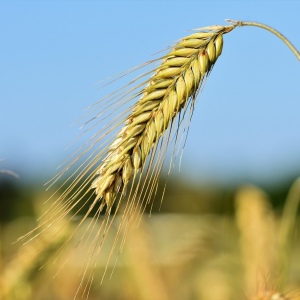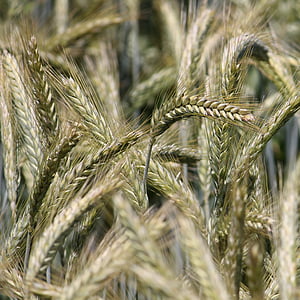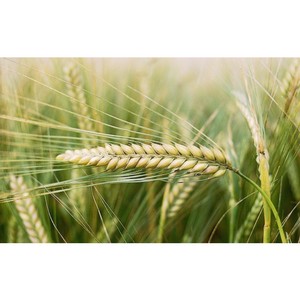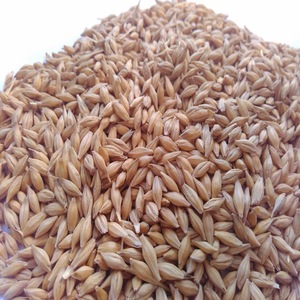Features of the technology of cultivation of barley
Barley is an ancient agricultural crop. It is grown for food, technical, feed purposes, and is used in brewing. Healthy drinks are prepared from this cereal, flour and cereals are made, and used in medicine. In addition, barley is sown as green manure in autumn along with oats and rye.
Interest in cultivation of crops is growing both among large and small farms. And this is not surprising - barley is rich in vitamins, microelements, fiber and serves as an excellent addition to the diet of those who look after their health and shape. In the material, we will tell you about the features of the technology of cultivation of barley, the timing of sowing, the recommended and unacceptable predecessors.
The content of the article
Features of growing technology
Barley is an unpretentious cereal and does not require special growing conditions. The culture is cultivated practically throughout the entire territory of our country.
Recommended predecessors
Barley has not been grown in the same location for more than three years in a row. It is distinguished by a poorly developed root system and, as a result, a low ability to absorb nutrients from the soil. In this regard, barley is sown in areas with fertile soil, free from weeds.
The best predecessors are potatoes, corn and other cultivated crops, leaving after harvesting fields clean of weeds, as well as winter crops, under which organic and mineral fertilizers, other cereals, fiber flax, perennial grasses, green manure were applied.
Reference. For forage purposes, barley can be sown after legumes. If the grain is intended for brewing, then legumes are unacceptable predecessors for barley. This is due to the fact that grain quality decreases due to abundant tillering.
Moisture requirements

Barley is drought-resistant and less demanding on moisture than oats and spring wheat. Therefore, in arid steppe regions, it shows a higher yield. In terms of drought tolerance, the culture ranks first among cereals.
Barley seeds sprout in well-moistened soil. When they swell, they absorb up to 50% of the moisture content of the dry seed mass. This is less than, for example, oats.
The plant experiences the greatest need for moisture in the phase of going into the tube and at the beginning of earing. Lack of water in the formation of the reproductive parts of the plant is detrimental to pollen. As a result, the number of sterile flowers increases and the yield decreases.
Light and heat requirements
Barley is a long-day cereal. The lack of sunlight slows down the earing process. The growing season for barley is 70 to 110 days. This is the earliest ripening crop among cereals.
The culture is undemanding to heat. Seeds germinate when warming up to + 1 ... + 2 ° С. At the same time, the sprouts are able to withstand a decrease in temperature to -5 ° C.
Winter crop varieties withstand prolonged frosts at the depth of the tillering node up to -10 ... -12 ° С. Winter barley in early spring quickly regains its growth and goes into the tube.
Grain tolerates high temperatures well, so it is successfully grown in the southernmost regions. When the air temperature rises to + 40 ° C, stomatal paralysis occurs only after 12 hours, while in oats - after 4-6 hours.
Soil requirements
Barley is notable for showing high yields on various types of soils. It is successfully cultivated both on podzolic soils in the northern regions and on saline soils in the southeast.
Important. It is preferable to use highly nutritious structural soils for growing barley. The reaction of the soil is neutral or slightly alkaline.
Strongly acidified podzolic soils are not used. At the same time, you can see how barley grows in the most northern regions. They use specially bred varieties. They give high yields even in such unfavorable conditions.
Drained swamp lands and cultivated peatlands are also used for barley. Sandy and highly saline soils are of little use for the cultivation of cereals, including barley.
Seed preparation for sowing

The seed is used large, with high germination. Before sowing, the seeds are disinfected with fungicides and treated with stimulants for effective growth.
Etching is carried out 2-3 months before the start of sowing work. To do this, use drugs such as "Fundazol" 50% or "Vitavax 200" 75%.
Disinfection of seed material allows you to significantly control and limit the development of such dangerous diseases as root rot, dusty and hard smut.
Sowing terms and methods
When is barley sown? Sowing of spring barley begins in the first half of spring, as soon as the equipment can go out into the fields. In the southern regions, sowing begins in early March. And in areas of limited and risky farming - in April-May. For example, the sowing date for barley in the Kemerovo region begins at the end of April.
Barley is a continuous sowing crop. It is sown in a narrow-row method, leaving 7.5 cm between rows, or in the usual row method with a row spacing of 15 cm. The narrow-row method of sowing provides an optimal feeding area. This creates favorable conditions for the growth and development of culture.
In small farms and in private plots, barley is sown by hand.
With sufficient soil moisture, the seeds are planted 4-5 cm on heavy soils and 5-6 cm on light sandy loam soils. In dry weather, the embedding depth is increased to 7-8 cm.
Attention. Barley is an early sowing crop. A delay in the sowing campaign leads to a decrease in yield.
Sowing of winter barley is carried out from September to October. The specific sowing time depends on the region of cultivation.
Fertilization
To obtain a rich harvest, it is important to provide the plants with the necessary nutrition in the early stages of growth. It is almost impossible to compensate for the lack of trace elements later.
The soil is prepared in the fall. For plowing, phosphorus and potash fertilizers are applied. In the spring, before pre-sowing cultivation, the land is fertilized with nitrogen fertilization. In addition, phosphorus fertilizers are used during sowing. This scheme ensures proper development of the root system and the formation of larger ears.
Barley loves mineral fertilizers more than organic ones. Therefore, organic matter is applied directly under the barley. Microfertilizers activate enzymes that accelerate biochemical processes inside plants and increase the culture's resistance to diseases and lack of moisture.
Protection from pests and diseases
Protection of barley crops from diseases and pests lies in the correct agrotechnical methods.... These techniques include maintaining crop rotation, early fall plowing, adhering to sowing dates and seeding rates, using resistant varieties, using fertilizers and growth stimulants.
The most dangerous pests include the striped grain flea, the stem flea, and the cereal fly. At later stages of growth, these are aphids, turtle bugs, bread beetles. Pests are especially dangerous in hot spring weather, when the plants are still weak and insects are feeding heavily.
For pest control, insecticides are used, such as "Decis Profi", "VDG" (0.02 l / ha), "Sumi Alpha", "KE" (0.2 l / ha), "Fastak", "Karate Zeon ".
Important... Preventive insecticide treatments on the edge strips of the field (at a distance of 100-150 m from the edge) is an effective preventive measure. Most insects settle there in the first days of the season. Such treatments scare off pests and this is enough for the safety of crops.
Barley is not insured against diseases either. Crops are affected by dusty and hard smut, powdery mildew, rust, root rot, septoria.
A measure of disease prevention is seed dressing before sowing. To combat diseases, fungicides are used: "Tilt" - 25% (emulsion concentrate), "Bayleton" 25% (wettable powder) and "Fundazol".
To control weeds, they are treated with herbicides (2,4-D ammonium salt and "Dialalen").
Harvesting
Barley harvesting is carried out both by direct combining and separately. It is optimal to combine these methods, based on the state of crops and weather conditions.
Unevenly ripening and weedy crops are harvested separately, mowing into swaths at the end of the wax ripeness. Grain, ripe to firm ripeness, is harvested by direct combining. The level of yield and the quality of the finished product depend on the choice of the time and method of harvesting.
The timing of collection is set based on the state of crops, the method of harvesting, weather conditions. Delaying the harvest time, as well as carrying it out too early, reduces the yield indicators. With early harvesting, losses are caused by inadequate filling of weevils. In the case of late - the loss of kernels from the ear and breaking off the ears.
Direct combining is carried out in the phase of hard ripeness. The moisture content of the grain is 14-17%. In this case, the barley is well threshed and cleaned by a combine. Moreover, this grain does not require drying.
Separate harvesting is carried out at the end of wax ripeness. During this period, more than 80% of the ears turn completely yellow.
Need to know. Separate harvesting is carried out only with a sufficient density of stalks (280-300 pcs / sq. M) and their height not lower than 60 cm. Otherwise, the mass mowed into rolls falls through the stubble to the ground, which leads to large losses.
Seeding rate of spring barley seeds
Barley has a high tillering energy - it reacts more strongly to higher seeding rates than spring wheat. Thickened and thinned crops reduce yield and grain quality.
The seeding rate varies depending on soil fertility, field weediness, top dressing, predecessors, terms and methods of sowing. Weather conditions during the sowing period also affect the seeding rate determination.
With a narrow-row sowing method, the rate is increased by 10-15%... When sowing barley with perennial undercover grasses, the seeding rate is reduced by 15-20%. With improved nutritional conditions, the rate is reduced by 20%. Early ripening varieties are sown with an increased rate.
Determining the optimal plant density is a decisive factor in obtaining a high yield. If the density is insufficient, then the soil fertility is not fully utilized, the crops are contaminated. If the crops are thickened, then the plants lack moisture and nutrition.
The standard sowing rate of barley per 1 ha in kg is 165-215. This volume is approximately 3.5-4 million grains. Varieties prone to tillering and lodging are sown in smaller volumes.
For individual farming zones, the following indicative seeding rates for barley have been established. For steppe regions - 3.5-4 million. For forest-steppe and western regions - 4.5-5.0 million grains per hectare.
The higher the soil fertility and the less precipitation, the lower the seeding rate, and vice versa.
It is interesting:
Important nuances
Consider the following when growing barley:
- Barley grows well with most crops.It is grown with chickpeas, lentils, peas, rapeseed, and wheat.

- Winter barley ripens one to two weeks earlier than winter wheat. This contributes to the even use of machinery and labor during the harvest period.
- Barley is sensitive to feeding, as it has an underdeveloped root system. Fertilizing for deep plowing, as well as during sowing, significantly increases the yield.
- Cultivation of barley gives high yields during early sowing operations. Sufficiently moist soil and cool weather promote friendly emergence and development of the root system.
- A delay in the sowing campaign leads to a decrease in yield. Especially in the cultivation of barley in the south. Sowing here begins in early March, if weather conditions permit. Subsequent cold snaps do not damage crops.
Conclusion
Barley is a useful and unpretentious cereal to grow. His eat, for livestock feed, used in brewing, medicine and technical purposes. Knowledge of the peculiarities of the technology of growing barley can significantly increase the yield and quality of grain.